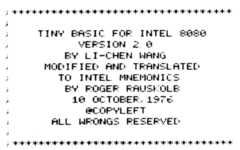
Li-Chen Wang
Encyclopedia

Intel 8080
The Intel 8080 was the second 8-bit microprocessor designed and manufactured by Intel and was released in April 1974. It was an extended and enhanced variant of the earlier 8008 design, although without binary compatibility...
-based microcomputer
Microcomputer
A microcomputer is a computer with a microprocessor as its central processing unit. They are physically small compared to mainframe and minicomputers...
s.
This was the fourth version of Tiny BASIC
Tiny BASIC
Tiny BASIC is a dialect of the BASIC programming language that can fit into as little as 2 or 3 KB of memory. This small size made it invaluable in the early days of microcomputers , when typical memory size was only 4–8 KB.- History :...
that appeared in Dr. Dobb's Journal of Computer Calisthenics & Orthodontia, but probably the most influential. It appeared in the May 1976 Vol 1, No. 5 issue, and distinguished itself from other versions of Tiny BASIC through a novel means of abbreviating commands to save memory, and the inclusion of an array variable ("@"). The interpreter occupied 1.77 kilobyte
Kilobyte
The kilobyte is a multiple of the unit byte for digital information. Although the prefix kilo- means 1000, the term kilobyte and symbol KB have historically been used to refer to either 1024 bytes or 1000 bytes, dependent upon context, in the fields of computer science and information...
s of memory and assumed the use of a TTY
TTY
TTY may stand for:* Teleprinter or Teletypewriter or Teletype Printer, a typewriter paired with an electronic communication channel, used for telecommunications or as a computer terminal....
for user input/output
Input/output
In computing, input/output, or I/O, refers to the communication between an information processing system , and the outside world, possibly a human, or another information processing system. Inputs are the signals or data received by the system, and outputs are the signals or data sent from it...
.
An erratum to the original article appeared in the June/July issue of Dr. Dobb's (Vol. 1, No 6.) This article also included information on adding additional I/O devices, using code for the VDM video display by Processor Technology as an example.
Dr. Wang also wrote a STARTREK program in his Tiny BASIC that appeared in the July, 1976 issue of the People's Computer Company newsletter.
The original prototype TRS-80 Model I that was demonstrated for Charles Tandy to sell the idea ran Li-Chen's BASIC.

Stringy floppy
The Exatron Stringy Floppy is a continuous loop tape drive that was developed by Exatron for use with the Radio Shack TRS-80 microcomputer, among others, and was launched in 1979. The tape cartridge is about the size of a credit card, but about twice as thick...
ROM for the TRS-80 Model I. According to Embedded Systems columnist Jack W. Crenshaw, Li-Chen's Manchester encoding code, achieving 14K read/write speeds, is a "work of art."
In 2001 Dr. Wang was re-elected for a 2nd term as chair of the Infrared Data Association's Technical and Test committee. In 2004 Dr. Wang was employed as Chief Technical Officer at ACTiSYS in Fremont, CA focused on IR/mobile products.

